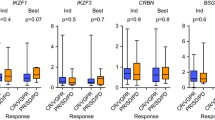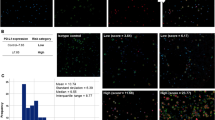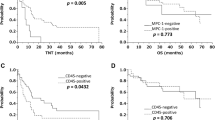Abstract
POEMS syndrome is a rare plasma cell disorder. Lenalidomide has recently emerged as a therapeutic option for POEMS syndrome. Cereblon has been identified as the direct target of lenalidomide, and high cereblon expression is associated with better response and outcome to lenalidomide therapy in multiple myeloma patients. Here, we analyzed the predictive value of cereblon, IKZF1, and IKZF3 in CD138+ selected plasma cells from forty-one newly diagnosed POEMS syndrome patients treated with lenalidomide in combination with dexamethasone at both gene and protein levels. We found that patients with high cereblon expression tended to achieve better hematologic response compared to those with low expression (p = 0.024 for gene expression; p = 0.01 for protein expression). Multivariate Cox regression analysis revealed high cereblon mRNA expression as an independent prognostic marker for longer progression-free survival (hazard ratio 0.542; 95% CI 0.337–0.871; p = 0.011). In conclusion, our results emphasized the role of cereblon mRNA expression as a unique biomarker for predicting the clinical response and outcome of lenalidomide-based therapy in newly diagnosed POEMS syndrome patients.


Similar content being viewed by others
Data availability
The datasets generated during and/or analyzed during the current study are available from the corresponding author on reasonable request.
Code availability
Statistical analysis was performed using the SPSS (version 23; Inc., Chicago, Illinois)
References
Cai QQ, Wang C, Cao XX, Cai H, Zhou DB, Li J (2015) Efficacy and safety of low-dose lenalidomide plus dexamethasone in patients with relapsed or refractory POEMS syndrome. Eur J Haematol 95(4):325–330. https://doi.org/10.1111/ejh.12492
Suichi T, Misawa S, Nagashima K, Sato Y, Iwai Y, Katayama K, Sekiguchi Y, Shibuya K, Amino H, Suzuki YI, Tsuneyama A, Nakamura K, Kuwabara S (2020) Lenalidomide treatment for thalidomide-refractory POEMS syndrome: a prospective single-arm clinical trial. Intern Med 59(9):1149–1153. https://doi.org/10.2169/internalmedicine.3800-19
Nozza A, Terenghi F, Gallia F, Adami F, Briani C, Merlini G, Giordano L, Santoro A, Nobile-Orazio E (2017) Lenalidomide and dexamethasone in patients with POEMS syndrome: results of a prospective, open-label trial. Br J Haematol 179(5):748–755. https://doi.org/10.1111/bjh.14966
Li J, Huang XF, Cai QQ, Wang C, Cai H, Zhao H, Zhang L, Cao XX, Gale RP, Zhou DB (2018) A prospective phase II study of low dose lenalidomide plus dexamethasone in patients with newly diagnosed polyneuropathy, organomegaly, endocrinopathy, monoclonal gammopathy, and skin changes (POEMS) syndrome. Am J Hematol 93(6):803–809. https://doi.org/10.1002/ajh.25100
Lu G, Middleton RE, Sun H, Naniong M, Ott CJ, Mitsiades CS, Wong KK, Bradner JE, Kaelin WG Jr (2014) The myeloma drug lenalidomide promotes the cereblon-dependent destruction of Ikaros proteins. Science 343(6168):305–309. https://doi.org/10.1126/science.1244917
Fischer ES, Bohm K, Lydeard JR, Yang H, Stadler MB, Cavadini S, Nagel J, Serluca F, Acker V, Lingaraju GM, Tichkule RB, Schebesta M, Forrester WC, Schirle M, Hassiepen U, Ottl J, Hild M, Beckwith RE, Harper JW, Jenkins JL, Thoma NH (2014) Structure of the DDB1-CRBN E3 ubiquitin ligase in complex with thalidomide. Nature 512(7512):49–53. https://doi.org/10.1038/nature13527
Shi Q, Chen L (2017) Cereblon: a protein crucial to the multiple functions of immunomodulatory drugs as well as cell metabolism and disease generation. J Immunol Res 2017:9130608–9130608. https://doi.org/10.1155/2017/9130608
Ito T, Ando H, Suzuki T, Ogura T, Hotta K, Imamura Y, Yamaguchi Y, Handa H (2010) Identification of a primary target of thalidomide teratogenicity. Science 327(5971):1345–1350. https://doi.org/10.1126/science.1177319
Broyl A, Kuiper R, van Duin M, van der Holt B, el Jarari L, Bertsch U, Zweegman S, Buijs A, Hose D, Lokhorst HM, Goldschmidt H, Sonneveld P, Dutch-Belgian H, German GG (2013) High cereblon expression is associated with better survival in patients with newly diagnosed multiple myeloma treated with thalidomide maintenance. Blood 121(4):624–627. https://doi.org/10.1182/blood-2012-06-438101
Heintel D, Rocci A, Ludwig H, Bolomsky A, Caltagirone S, Schreder M, Pfeifer S, Gisslinger H, Zojer N, Jager U, Palumbo A (2013) High expression of cereblon (CRBN) is associated with improved clinical response in patients with multiple myeloma treated with lenalidomide and dexamethasone. Br J Haematol 161(5):695–700. https://doi.org/10.1111/bjh.12338
Zhu YX, Braggio E, Shi CX, Bruins LA, Schmidt JE, Van Wier S, Chang XB, Bjorklund CC, Fonseca R, Bergsagel PL, Orlowski RZ, Stewart AK (2011) Cereblon expression is required for the antimyeloma activity of lenalidomide and pomalidomide. Blood 118(18):4771–4779. https://doi.org/10.1182/blood-2011-05-356063
Bila J, Sretenovic A, Jelicic J, Tosic N, Glumac I, Fekete MD, Antic D, Balint MT, Markovic O, Milojevic Z, Radojkovic M, Trajkovic G, Puric M, Pavlovic S, Mihaljevic B (2016) Prognostic significance of cereblon expression in patients with multiple myeloma. Clin Lymphoma Myeloma Leuk 16(11):610–615. https://doi.org/10.1016/j.clml.2016.08.007
Zhu YX, Braggio E, Shi CX, Kortuem KM, Bruins LA, Schmidt JE, Chang XB, Langlais P, Luo M, Jedlowski P, LaPlant B, Laumann K, Fonseca R, Bergsagel PL, Mikhael J, Lacy M, Champion MD, Stewart AK (2014) Identification of cereblon-binding proteins and relationship with response and survival after IMiDs in multiple myeloma. Blood 124(4):536–545. https://doi.org/10.1182/blood-2014-02-557819
Tachita T, Kinoshita S, Ri M, Aoki S, Asano A, Kanamori T, Yoshida T, Totani H, Ito A, Kusumoto S, Komatsu H, Yamagata K, Kubo K, Tohkin M, Fukuda S, Iida S (2020) Expression, mutation, and methylation of cereblon-pathway genes at pre- and post-lenalidomide treatment in multiple myeloma. Cancer Sci 111(4):1333–1343. https://doi.org/10.1111/cas.14352
Pourabdollah M, Bahmanyar M, Atenafu EG, Reece D, Hou J, Chang H (2016) High IKZF1/3 protein expression is a favorable prognostic factor for survival of relapsed/refractory multiple myeloma patients treated with lenalidomide. J Hematol Oncol 9(1):123. https://doi.org/10.1186/s13045-016-0354-2
Kronke J, Kuchenbauer F, Kull M, Teleanu V, Bullinger L, Bunjes D, Greiner A, Kolmus S, Kopff S, Schreder M, Mugge LO, Straka C, Engelhardt M, Dohner H, Einsele H, Bassermann F, Bargou R, Knop S, Langer C (2017) IKZF1 expression is a prognostic marker in newly diagnosed standard-risk multiple myeloma treated with lenalidomide and intensive chemotherapy: a study of the German Myeloma Study Group (DSMM). Leukemia 31(6):1363–1367. https://doi.org/10.1038/leu.2016.384
Feng J, Gao XM, Zhao H, He TH, Zhang CL, Shen KN, Zhang L, Cao XX, Qian M, Zhou DB, Li J (2020) Ischemic stroke in patients with POEMS syndrome. Blood Adv 4(14):3427–3434. https://doi.org/10.1182/bloodadvances.2020001865
Zhao H, Huang XF, Gao XM, Cai H, Zhang L, Feng J, Cao XX, Zhou DB, Li J (2019) What is the best first-line treatment for POEMS syndrome: autologous transplantation, melphalan and dexamethasone, or lenalidomide and dexamethasone? Leukemia 33(4):1023–1029. https://doi.org/10.1038/s41375-019-0391-2
Dispenzieri A (2019) POEMS Syndrome: 2019 Update on diagnosis, risk-stratification, and management. Am J Hematol 94(7):812–827. https://doi.org/10.1002/ajh.25495
Wang C, Huang XF, Cai QQ, Cao XX, Duan MH, Cai H, Zhou DB, Li J (2017) Prognostic study for overall survival in patients with newly diagnosed POEMS syndrome. Leukemia 31(1):100–106. https://doi.org/10.1038/leu.2016.168
Jonasova A, Bokorova R, Polak J, Vostry M, Kostecka A, Hajkova H, Neuwirtova R, Siskova M, Sponerova D, Cermak J, Mikulenkova D, Cervinek L, Brezinova J, Michalova K, Fuchs O (2015) High level of full-length cereblon mRNA in lower risk myelodysplastic syndrome with isolated 5q deletion is implicated in the efficacy of lenalidomide. Eur J Haematol 95(1):27–34. https://doi.org/10.1111/ejh.12457
Huang SY, Lin CW, Lin HH, Yao M, Tang JL, Wu SJ, Chen YC, Lu HY, Hou HA, Chen CY, Chou WC, Tsay W, Chou SJ, Tien HF (2014) Expression of cereblon protein assessed by immunohistochemicalstaining in myeloma cells is associated with superior response of thalidomide- and lenalidomide-based treatment, but not bortezomib-based treatment, in patients with multiple myeloma. Ann Hematol 93(8):1371–1380. https://doi.org/10.1007/s00277-014-2063-7
Jamroziak K, Szemraj J, Robak T, Tukiendorf A, Giannopoulos K (2015) Cereblon expression predicts clinical response in chronic lymphocytic leukemia treated with a thalidomide/fludarabine regimen. Leuk Lymphoma 56(3):808–810. https://doi.org/10.3109/10428194.2014.933215
Sardnal V, Rouquette A, Kaltenbach S, Bally C, Chesnais V, Leschi C, Ades L, Santini V, Park S, Toma A, Fenaux P, Dreyfus F, Fontenay M, Kosmider O (2013) A G polymorphism in the CRBN gene acts as a biomarker of response to treatment with lenalidomide in low/int-1 risk MDS without del(5q). Leukemia 27(7):1610–1613. https://doi.org/10.1038/leu.2013.59
Yang Y, Shaffer AL 3rd, Emre NC, Ceribelli M, Zhang M, Wright G, Xiao W, Powell J, Platig J, Kohlhammer H, Young RM, Zhao H, Yang Y, Xu W, Buggy JJ, Balasubramanian S, Mathews LA, Shinn P, Guha R, Ferrer M, Thomas C, Waldmann TA, Staudt LM (2012) Exploiting synthetic lethality for the therapy of ABC diffuse large B cell lymphoma. Cancer Cell 21(6):723–737. https://doi.org/10.1016/j.ccr.2012.05.024
Zhang LH, Kosek J, Wang M, Heise C, Schafer PH, Chopra R (2013) Lenalidomide efficacy in activated B-cell-like subtype diffuse large B-cell lymphoma is dependent upon IRF4 and cereblon expression. Br J Haematol 160(4):487–502. https://doi.org/10.1111/bjh.12172
Dimopoulos K, Fibiger Munch-Petersen H, Winther Eskelund C, Dissing Sjo L, Ralfkiaer E, Gimsing P, Gronbaek K (2019) Expression of CRBN, IKZF1, and IKZF3 does not predict lenalidomide sensitivity and mutations in the cereblon pathway are infrequent in multiple myeloma. Leuk Lymphoma 60(1):180–188. https://doi.org/10.1080/10428194.2018.1466290
Acknowledgements
The authors thank the patients that participated in this study.
Funding
This study was funded by Natural Science Foundation of Ningbo (Grant Number: 2019A610275).
Author information
Authors and Affiliations
Contributions
Q-Q.C was involved in study design, data collection, and analysis and performed the experiments and wrote the paper; X-M.G and H.Z collected the data and performed the experiments; Jing Le and X-X.C analyzed and interpreted the data; and H.C measured serum VEGF. Jian Li designed the study, recruited the patients, analyzed the data, wrote the manuscript, and revised the manuscript. All authors have approved the final manuscript.
Corresponding author
Ethics declarations
Ethics approval
The study was approved by the local ethics committee (No. S-586) and was registered with ClinicalTrials.gov as NCT01816620.
Consent to participate
Informed consent was obtained from all individual participants included in the study.
Consent for publication
All of the authors have agreed with the publication.
Conflicts of interest
The authors declare no competing interests.
Additional information
Publisher’s note
Springer Nature remains neutral with regard to jurisdictional claims in published maps and institutional affiliations.
Rights and permissions
About this article
Cite this article
Cai, Qq., Gao, Xm., Le, J. et al. Cereblon expression is a prognostic marker in newly diagnosed POEMS syndrome treated with lenalidomide plus dexamethasone. Ann Hematol 100, 1547–1552 (2021). https://doi.org/10.1007/s00277-021-04517-9
Received:
Accepted:
Published:
Issue Date:
DOI: https://doi.org/10.1007/s00277-021-04517-9




